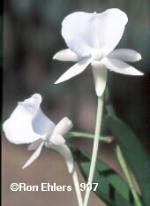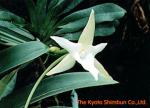|
|
AngraecumFamily: Orchidaceae.
|
|
|
 |
Genus of about 200 species of monopoidal orchids, which are mostly evergreen and epiphytic. They have semirigid, linear to oblong leaves, produced in 2 ranks. Flowers are white, green or yellowish green. All the flowers have a spurred lip which encircles the column at its base, and the rostellum is bifid.
Angraecum is easy to grow once good roots have been established. Most species appreciate a decided rest in cooler condition after flowering.
Belongs to the group of monopodial orchids, having, usualy, a simple branchless stem, gaining height very slowly. The flowers produce a strong aroma in the nighttime. |
|
| Growing conditions |
Watering and misting |
Propagation |
| Medium warmth, with slightly cooler winter tempterature, very humid air, needs shade from the direct sunlight, and a continuous flow of fresh air is essential. Grow epiphytically in epiphyptic orchid potting mix. |
Water freely all year, sparingly in winter. Misting is necessary once or twice daily. |
Not suitable for division, although robust species sometimes produce offsets, which may be detached after they have formed roots. |
|
Angraecum distichum |
|
|
Small African species producing many white flowers. |
 |
|
Angraecum eburneum Bory. |
|
|
Strong plant, with straight standing, dense leaved stem, from which extend multiple aerial roots. Long inflorencences, forming at the base of the leaves, carrying 15-30 greenish white fragrant flowers about 10 cm (4 in) in diameter. Blooms in October-November. |
 |
|
Angraecum Longiscott |
|
|
Small African species producing many white flowers. |
 |
|
Angraecum magdalenae |
|
|
Another of the African species that is fragrant at night. This plant stays nice and compact, does not get out of hand like some other angraecoids. A reliable bloomer. Likes intermediate temperatures with moderate light. Large white, showy flower. |
 |
|
Angraecum sesquipedale Thou. |
|
|
Strong straight-standing stems up to 60 cm (2 feet), sometimes reaching up to 1 m (3-3.5 ft), covered with dense leaves up to 50 cm (20 in) in length and 7 cm (2.5 in) in width. The flowers are the biggest in genus, 12-15 cm (up to 7 in) across, star shaped, waxy, yellowish. Blooms in December-February. |
 |
|
These materials are freely provided for instructional and educational purposes. Any duplication or publication of text or images herein for commercial gain without explicit written permission of the owner or photographer constitutes breach of trust and violation of copyright.
Copyright © Galka Okhapkina 1998-2025






